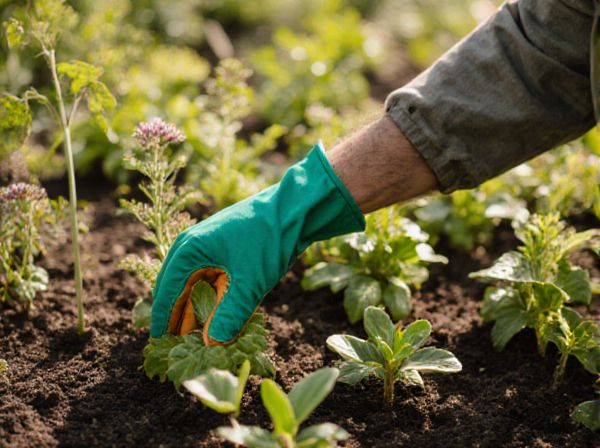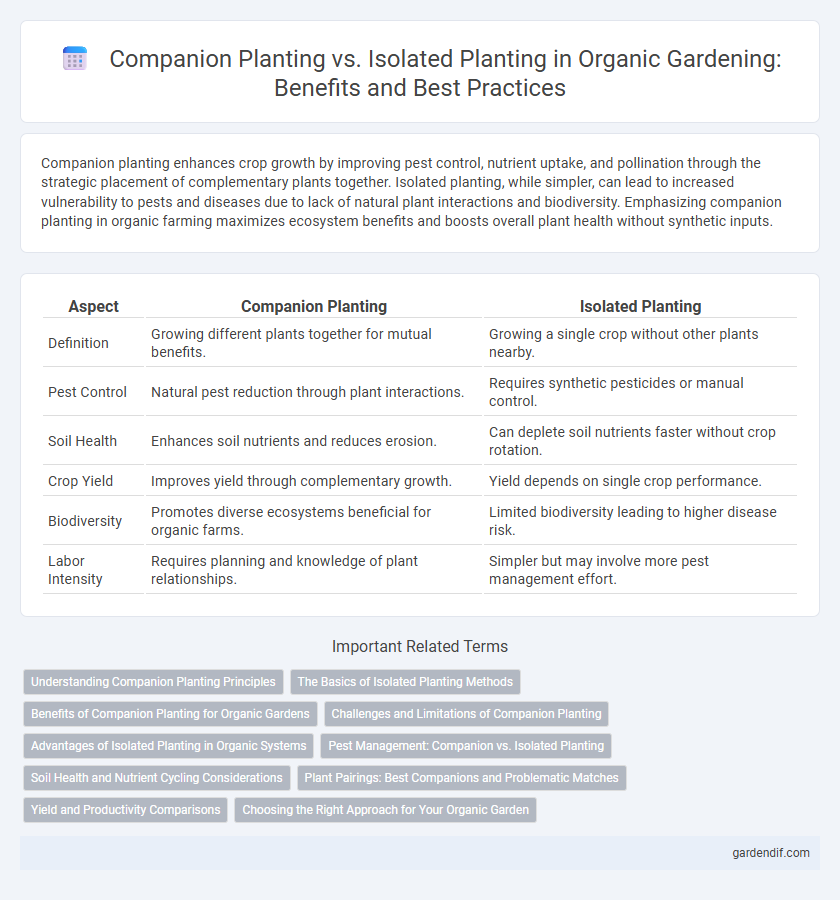
Companion planting vs isolated planting Illustration
Companion planting enhances crop growth by improving pest control, nutrient uptake, and pollination through the strategic placement of complementary plants together. Isolated planting, while simpler, can lead to increased vulnerability to pests and diseases due to lack of natural plant interactions and biodiversity. Emphasizing companion planting in organic farming maximizes ecosystem benefits and boosts overall plant health without synthetic inputs.
Table of Comparison
| Aspect | Companion Planting | Isolated Planting |
|---|---|---|
| Definition | Growing different plants together for mutual benefits. | Growing a single crop without other plants nearby. |
| Pest Control | Natural pest reduction through plant interactions. | Requires synthetic pesticides or manual control. |
| Soil Health | Enhances soil nutrients and reduces erosion. | Can deplete soil nutrients faster without crop rotation. |
| Crop Yield | Improves yield through complementary growth. | Yield depends on single crop performance. |
| Biodiversity | Promotes diverse ecosystems beneficial for organic farms. | Limited biodiversity leading to higher disease risk. |
| Labor Intensity | Requires planning and knowledge of plant relationships. | Simpler but may involve more pest management effort. |
Understanding Companion Planting Principles
Companion planting involves strategically growing different plants together to enhance growth, improve pest control, and increase biodiversity within organic gardens. Principles include selecting plants with complementary nutrient requirements, pest deterrence properties, and growth habits that optimize space and resources. This method contrasts with isolated planting, which lacks the mutual benefits derived from plant interactions, potentially leading to decreased resilience and productivity.
The Basics of Isolated Planting Methods
Isolated planting methods involve growing crops separately to prevent cross-contamination, disease spread, and unwanted cross-pollination, ensuring genetic purity and better pest control. This technique enhances crop management by minimizing competition for resources and reducing the risk of parasite and weed infestation. Isolated planting is essential in organic agriculture for maintaining plant health, supporting biodiversity, and improving overall crop quality.
Benefits of Companion Planting for Organic Gardens
Companion planting enhances organic gardens by naturally improving pest control and increasing crop yields without synthetic chemicals. Certain plant combinations, such as marigolds with tomatoes, repel harmful insects while attracting beneficial pollinators, promoting healthier growth. This method also enriches soil fertility through complementary root systems, reducing the need for chemical fertilizers and supporting sustainable garden ecosystems.
Challenges and Limitations of Companion Planting
Companion planting faces challenges such as unpredictable interactions between plant species, which can lead to competition for nutrients, water, and sunlight, reducing overall crop yield. Managing spatial arrangement to optimize beneficial relationships requires detailed knowledge and can be labor-intensive, limiting its practicality for large-scale organic farming. Pest and disease suppression through companion planting is not always reliable, making it necessary to combine with other organic pest control methods for consistent results.
Advantages of Isolated Planting in Organic Systems
Isolated planting in organic systems minimizes cross-contamination from pests and diseases, enhancing plant health and yield consistency. It allows for precise control over nutrient management and reduces competition for resources, promoting optimal growth. This method supports biodiversity by creating distinct habitats, which can naturally regulate pest populations without relying on synthetic inputs.
Pest Management: Companion vs. Isolated Planting
Companion planting enhances pest management by naturally deterring harmful insects through the strategic pairing of plants that repel pests or attract beneficial predators. Isolated planting often lacks this protective interaction, making crops more vulnerable to infestations and increasing reliance on chemical pesticides. Integrating companions like marigolds with tomatoes reduces nematode damage and limits pest spread, promoting healthier, organic growth.
Soil Health and Nutrient Cycling Considerations
Companion planting enhances soil health by promoting diverse root structures that improve aeration and microbial activity, leading to efficient nutrient cycling and reduced pest pressure. In contrast, isolated planting often results in nutrient depletion due to monoculture practices that limit organic matter input and disrupt beneficial microbial communities. Integrating diverse companion plants fosters a balanced ecosystem that supports long-term soil fertility and sustainable organic farming.
Plant Pairings: Best Companions and Problematic Matches
Companion planting enhances organic gardens by pairing plants that boost growth, repel pests, or improve flavor, such as tomatoes with basil or carrots with onions. In contrast, isolated planting avoids negative interactions between problematic matches like cabbage and strawberries, which can stunt each other's development. Understanding compatible plant pairings maximizes garden health and yield while minimizing the need for chemical interventions.
Yield and Productivity Comparisons
Companion planting enhances yield and productivity by promoting natural pest control, improving soil fertility through nitrogen fixation, and optimizing space utilization compared to isolated planting. Studies show mixed cropping systems can increase overall crop yield by up to 30% due to synergistic plant interactions. In contrast, isolated planting often requires more chemical inputs and offers lower biodiversity, resulting in reduced long-term soil health and productivity.
Choosing the Right Approach for Your Organic Garden
Companion planting enhances organic garden health by naturally deterring pests and improving soil nutrients through strategic plant combinations like basil with tomatoes or marigolds near beans. Isolated planting minimizes disease spread and pest infestation by spacing plants apart, which can be effective for crops vulnerable to specific pathogens. Selecting the right approach depends on your organic garden goals, plant types, and local ecosystem conditions to maximize growth and sustainability.
Companion planting vs isolated planting Infographic

 gardendif.com
gardendif.com